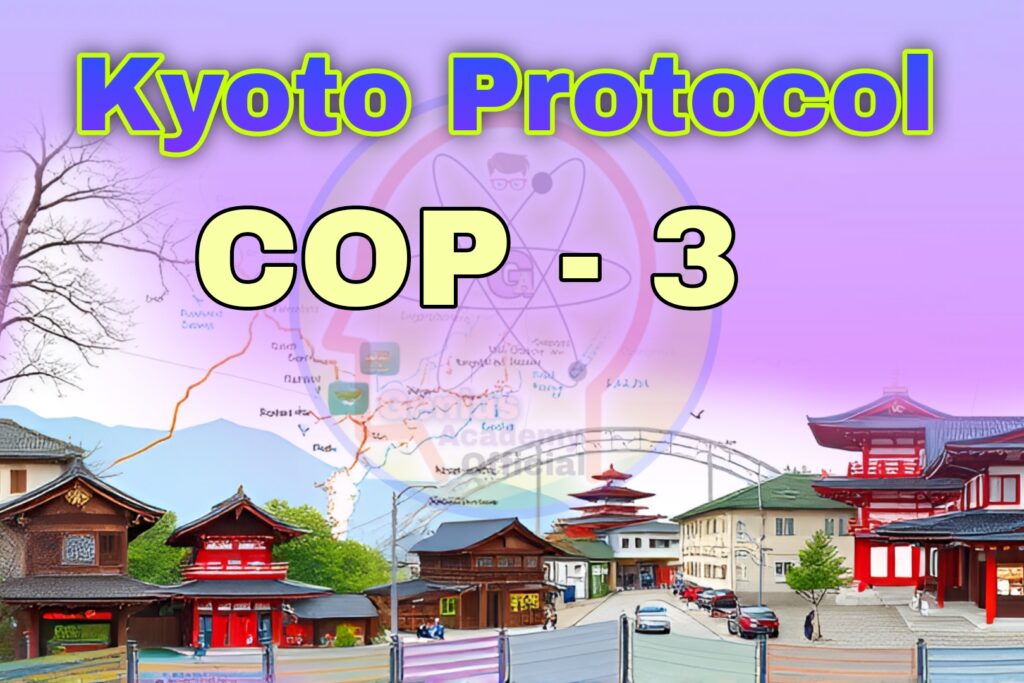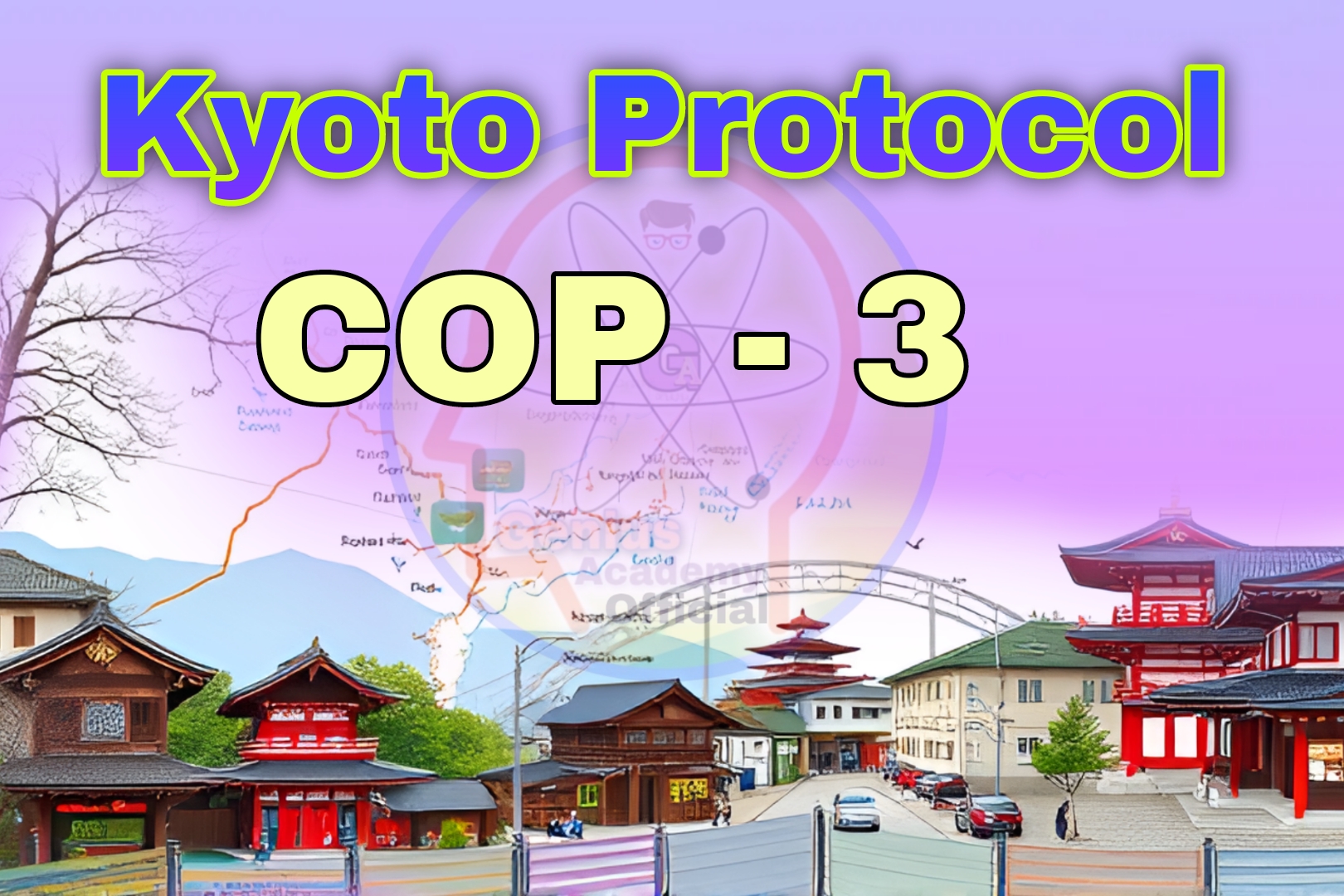
COP 3 : The Kyoto Protocol
The Kyoto Protocol, adopted in Kyoto, Japan, in 1997, is a pioneering international agreement under the United Nations Framework Convention on Climate Change (UNFCCC). It established legally binding commitments for developed countries to reduce greenhouse gas (GHG) emissions, marking a significant step forward in global climate action.
Key Facts about the Kyoto Protocol
- Adoption:— December 1997 in Kyoto, Japan
- Ratification by India:— 2002 (India became a signatory to the Kyoto Protocol on August 26, 2002.)
- The protocol officially took effect in February 2005.
- Parties Involved:— 192 as of today
- In 2012, the Doha Amendment was adopted in Qatar, extending the Kyoto Protocol’s commitment period from 2013 to 2020.
- Notable Absences:— The United States never ratified the Protocol, and Canada withdrew in 2012
Objective of the Kyoto Protocol
The Protocol’s main goal is to combat global warming by reducing GHG concentrations to levels that would prevent hazardous human impacts on the climate system. It aimed to reduce emissions from developed countries by 5% by 2012 relative to 1990 levels.
Principles of the Kyoto Protocol
The Kyoto Protocol operates on the principle of Common but Differentiated Responsibilities (CBDR). This concept holds developed nations accountable for their historical role in increasing GHG emissions, while recognizing the need for developing nations to focus on growth and development.
- Common Responsibilities:— Every nation has a shared obligation to address climate change.
- Differentiated Responsibilities:— Historically significant emitters (developed countries) are required to take greater responsibility and commit to stricter emission targets, while developing countries can engage voluntarily without mandatory reductions.
Greenhouse Gases Targeted by the Kyoto Protocol
The Kyoto Protocol identified specific gases to target for emissions reduction:—
- Carbon dioxide (CO₂)
- Methane (CH₄)
- Nitrous oxide (N₂O)
- Sulfur hexafluoride (SF₆)
- Hydrofluorocarbons (HFCs)
- Perfluorocarbons (PFCs)
Structure of Responsibilities Under the Kyoto Protocol
The Protocol classifies countries into various groups, each with specific commitments.
| Classification | Description | Commitments |
|---|---|---|
| Annex I | Developed countries and Economies in Transition (EIT) (e.g., US, UK, Russia, Ukraine, Turkey, some Eastern European countries). | Annex I countries have binding targets for GHG emissions reductions, given their high levels of historical emissions. |
| Annex II | Developed countries within Annex I (subset of Annex I) like the U.S. and EU nations. | Must provide financial and technical assistance to EITs and developing countries to help them reduce GHG emissions and adapt to climate impacts. |
| Annex B | Countries from Annex I with specified GHG reduction targets. | Compulsory, binding GHG emission reduction targets. ● First-round targets (2008-2012): Mandatory targets to reduce emissions within specified years. ● Second-round targets (2013-2020): New targets established to continue reducing emissions beyond the first period. |
| Non-Annex I | Countries not listed in Annex I (primarily low-income, developing countries). | No binding emissions reduction targets but may implement voluntary actions to mitigate climate change. |
| Least Developed Countries (LDCs) | Countries classified as least developed by the UN (low-income). The world’s most vulnerable and economically challenged nations. | Exempt from binding GHG reduction targets but may receive support to improve resilience and address climate impacts. (No mandatory GHG reduction targets, but they are encouraged to take voluntary actions.) |
| Annex B (First Period Only) | Annex B countries with binding targets only for the first commitment period (2008-2012). | Binding targets for the first period but not the second. |
| Annex B (Second Period) | Annex B countries with targets for the second commitment period (2013-2020). | Binding GHG reduction commitments for the second period. |
| Non-Annex B | Countries without binding targets under the Kyoto Protocol. | Not obligated to reduce GHG emissions but can participate voluntarily. |
| Withdrawn from Protocol | Annex B parties that withdrew from the Protocol, thus not bound by any commitment periods. | Initially had binding targets but later withdrew, nullifying their commitments. |
| Signatories Not Ratified | Countries that signed but have not ratified the Kyoto Protocol. | No legal obligation to meet Kyoto Protocol targets until ratification. |
| Non-Party UN Member States | UN member states and observers not part of the Kyoto Protocol. | Not bound by any Kyoto Protocol commitments but may participate in UNFCCC activities. |
Commitment Periods and the Doha Amendment
The Kyoto Protocol initially included two commitment periods to set targets for developed countries:
- First Commitment Period (2008–2012):— Over 35 countries committed to binding targets. Failing to meet targets resulted in a penalty requiring an additional reduction in the next period.
- Second Commitment Period (2013–2020):— Defined by the Doha Amendment in 2012, this period established new targets. The amendment required 144 ratifications to come into effect, which occurred in 2020, concluding the same year.
Canada exited the Protocol in 2012, and Japan, New Zealand, and Russia did not take on new targets for the second period.
Criticisms of the Kyoto Protocol
The Kyoto Protocol has faced several criticisms, primarily regarding the flexibility mechanisms and limited inclusivity.
- Carbon Credits and Trading:— Annex I countries could achieve targets by either cutting emissions or buying carbon credits, sometimes allowing them to avoid comprehensive domestic action. Critics argue that this approach neglects the social and economic impacts of climate change and sidesteps substantial commitments.
- CBDR and Exclusions:— The CBDR principle allowed certain nations, particularly rapidly growing economies like China and India, to increase emissions while developed nations committed to cuts. With China and India now among the largest global emitters, some see this as a missed opportunity for more equitable responsibilities.
Conclusion
The Kyoto Protocol was groundbreaking in formalizing GHG reduction commitments for developed countries, but its framework and implementation faced challenges, particularly in gaining universal participation and adequately addressing the complex needs of developing nations. Despite these issues, the Protocol paved the way for future agreements, such as the Paris Agreement, which aims for a more inclusive and flexible approach to climate action.

